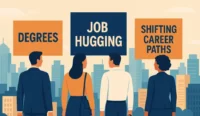The Growing Skills Gap: Why Young Americans Feel Unprepared
In today’s rapidly evolving job market, youth employment crisis has become a pressing concern for America’s economic future. According to a groundbreaking national study, “The Broken Marketplace,” nearly half of Generation Z feels unprepared for both current and future employment opportunities. This alarming statistic reveals a fundamental disconnect between young people’s aspirations and the systems designed to support them.
The research, conducted in part by the Schultz Family Foundation, exposes a troubling reality: more than 40% of young Americans believe the education system and career guidance professionals are failing to provide relevant direction for today’s job market. This youth employment crisis isn’t merely about personal frustration—it represents a significant threat to economic growth and social mobility.
The Misalignment Problem: Outdated Guidance in a Rapidly Changing Economy
Parents Relying on Outdated Experience
One critical factor contributing to the youth employment crisis is the guidance young people receive from their parents. As Rajiv Chandrasekaran, Managing Director at the Schultz Family Foundation, explains: “Parents are relying more on their own personal experiences, what they’re hearing from friends and relatives, as opposed to consulting up-to-date resources, doing their own research.”
This reliance on outdated information creates a generational knowledge gap that leaves young people unprepared for contemporary workplace realities. While parents’ intentions are good, their understanding of current job market requirements often fails to account for:
- Rapid technological transformation across industries
- Emerging career paths that didn’t exist during their own education
- New credentialing and certification requirements
- Changing employer expectations regarding skills and experience
- The impact of artificial intelligence on traditional career trajectories
Overwhelmed School Counselors
The youth employment crisis is further exacerbated by structural issues within the education system itself. As Chandrasekaran notes: “Guidance counselors are overwhelmed in high schools, and they too are offering them advice based on what might have worked maybe five, ten, 15 years ago.”
This systemic problem stems from several factors:
- Insufficient counselor-to-student ratios (often 1:500 or higher)
- Limited professional development opportunities for counselors
- Outdated career resource materials and assessment tools
- Insufficient connections with employers and industry representatives
- Inadequate training on emerging career fields and pathways
The combination of these factors creates an information vacuum that leaves young people without reliable guidance during critical career decision points.
The Social Media Solution: How Gen Z is Self-Navigating
TikTok as Career Counselor
Perhaps the most revealing finding about the youth employment crisis is how young people are responding to this guidance vacuum. Rather than waiting for institutions to catch up, they’re turning to alternative information sources.
“Young adults aren’t waiting for the adults and the institutions around them to fix themselves. They are taking matters into their own hands,” Chandrasekaran explains. “For many, many young adults, social media has emerged as their de facto career coach.”
The research reveals that an astonishing 70% of young adults now seek education and career guidance from social media platforms like:
- TikTok
- YouTube
This shift represents both opportunity and risk. While some content creators provide valuable insights and practical advice, others may promote unrealistic expectations or misguided career strategies. Without proper context or verification standards, young people may make significant life decisions based on incomplete or inaccurate information.
The Economic Consequences: A Warning Bell for America’s Future
The Alarming Unemployment Statistics
The youth employment crisis isn’t merely theoretical—it’s reflected in troubling labor market statistics. According to Chandrasekaran, “The unemployment rate for 18 to 19 year olds with no college is about 14.5%, one of the highest rates it’s been in years.”
This statistic represents just the tip of the iceberg. The research reveals that of the approximately 30 million young adults in America between 18 and 24:
- About 15 million are underemployed
- Many are trapped in low-wage jobs with limited advancement opportunities
- Others remain unemployed despite actively seeking work
- Most lack clear pathways to stable, middle-class careers
These numbers represent not just individual struggles but a collective economic challenge that threatens America’s competitive position in the global economy.
The Skills-Jobs Mismatch
At the heart of the youth employment crisis lies a paradoxical reality: millions of unfilled jobs exist alongside millions of unemployed or underemployed young people. As Chandrasekaran notes, “We have millions of unfilled jobs in America, but they require, in many cases, skills. You need certain credentials, you need specialized training. Just a basic high school degree is no longer enough.”
This mismatch between available opportunities and workforce preparation represents a fundamental economic inefficiency with far-reaching consequences:
- Reduced economic productivity and growth
- Increased social service costs
- Delayed wealth building for an entire generation
- Widening inequality between skilled and unskilled workers
- Competitive disadvantages in global markets
Solutions: Bridging the Education-Employment Gap
Employer-Education Alignment
Addressing the youth employment crisis requires systematic collaboration between key stakeholders. “What we believe is that employers and the education system need to better align themselves,” Chandrasekaran explains.
This alignment could take several forms:
- Industry-education partnerships that inform curriculum development
- Work-based learning opportunities integrated into educational programs
- Employer input on credential requirements and skill standards
- Career pathway programs that connect education to specific industry needs
- Transparent communication about entry-level job requirements
Modernizing Career Guidance
Another critical component in resolving the youth employment crisis involves updating the career guidance ecosystem to reflect contemporary realities. This includes:
- Providing parents with current labor market information and resources
- Investing in professional development for school counselors
- Creating digital career exploration tools that reflect emerging opportunities
- Developing industry-specific mentorship programs
- Incorporating career readiness into core educational experiences
Leveraging Technology Constructively
Rather than viewing social media as a competitor to traditional guidance, schools and employers can embrace these platforms as complementary tools. Effective strategies might include:
- Creating high-quality career content specifically for platforms like TikTok and Instagram
- Partnering with credible influencers to share accurate career information
- Developing verification standards for career advice content
- Teaching young people media literacy skills for evaluating career information
- Connecting online exploration to real-world opportunities
FAQ: Youth Employment Crisis
What factors are contributing to the current youth employment crisis?
The youth employment crisis stems from multiple interconnected factors. First, rapid technological change, particularly artificial intelligence and automation, has transformed job requirements faster than educational systems can adapt. Second, career guidance from parents and school counselors often relies on outdated information that doesn’t reflect current market realities. Third, the traditional pathway from high school to employment has fragmented, requiring additional credentials and specialized training that many young people lack access to. Finally, there’s insufficient communication between employers and educational institutions about skill requirements, creating a misalignment between what students learn and what employers need.
How is social media influencing young people’s career decisions during this youth employment crisis?
Social media has emerged as a significant force in the youth employment crisis, with 70% of young adults now turning to platforms like TikTok, Instagram, and YouTube for career guidance. This shift represents both opportunities and challenges. On the positive side, these platforms democratize access to career information and expose young people to diverse professional paths they might not otherwise consider. However, the quality of this guidance varies dramatically, with some content creators offering practical, evidence-based advice while others promote unrealistic expectations or misguided strategies. Without proper context or verification standards, young people may make significant career decisions based on incomplete or inaccurate information.
What are the economic implications of the ongoing youth employment crisis?
The youth employment crisis poses serious economic threats at both individual and national levels. With approximately 15 million young adults between 18-24 either underemployed, trapped in low-wage jobs, or unemployed, we’re seeing delayed wealth building for an entire generation. This translates to reduced consumer spending, delayed homeownership, and postponed family formation—all factors that traditionally drive economic growth. At the macroeconomic level, the mismatch between millions of unfilled jobs and millions of unprepared workers creates productivity gaps that hamper America’s competitive position in the global economy. If unaddressed, this crisis could lead to structural unemployment, widening inequality, and diminished economic mobility for decades to come.
What solutions could help address the education-employment gap fueling the youth employment crisis?
Resolving the youth employment crisis requires systematic collaboration between key stakeholders. First, employers and educational institutions must develop stronger partnerships that inform curriculum development and create work-based learning opportunities. Second, career guidance systems need modernization through professional development for counselors and creation of digital exploration tools that reflect emerging opportunities. Third, credential pathways need greater transparency and accessibility, with clear information about which credentials lead to which opportunities. Finally, we need to leverage technology constructively by creating high-quality career content for social media platforms and teaching young people media literacy skills for evaluating career information. These coordinated efforts can help bridge the gap between education and employment while preparing young people for sustainable career success.






